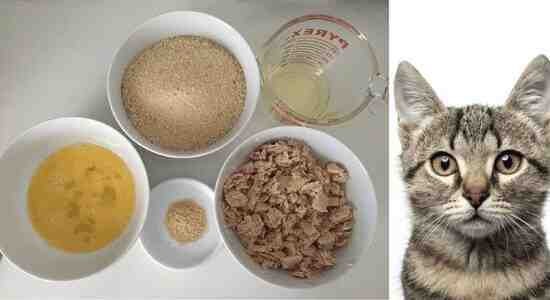Cats are not only adorable companions but also cherished family members. As responsible cat owners, we strive to provide the best possible care, including their diet.
One essential aspect of feline nutrition is choosing the right cat food. In this article, we will delve into the world of dry cat food and explore a special recipe that will keep your furry friend healthy and happy.
So, let’s uncover the secrets of creating a nutritious and delicious special recipe for dry cat food!
Table of Contents
Understanding the Importance of a Balanced Diet for Cats
As obligate carnivores, cats need a diet mostly composed of meat. A balanced diet is essential for their general health and well-being.
Your cat will get all the vitamins, minerals, and nutrients from a well-balanced diet to support growth, keep a healthy weight, and ward off illnesses.
The Role of Dry Cat Food in Feline Nutrition
Dry cat food, known as kibble, offers several benefits regarding convenience, dental health, and cost-effectiveness.
It is a popular choice among cat owners worldwide. But not all commercially available dry cat food options are the same.
You can prepare a personalized dry cat food recipe to suit your cat’s dietary requirements.

The Special Recipe for Dry Cat Food: A Delectable Delight
Making your own unique dry cat food recipe enables you to make sure that your feline friend is getting the best nutrition possible.
Let’s start with the detailed procedure for preparing this dish, which is full of vital nutrients and tastes your cat will like.
Step 1: Gather the Ingredients
To begin, gather the following high-quality ingredients:
1. Chicken meal
2. Salmon meal
3. Brown rice
4. Sweet potato
5. Pea fiber
6. Chicken fat
7. Natural flavors
8. Fish oil
9. Taurine
10. Vitamins and minerals
Step 2: Prepare the Ingredients
1. Start by preheating your oven to 350°F (175°C).
2. combine the chicken meal, salmon meal, brown rice, sweet potato, and pea fiber in a large mixing bowl. Mix well to ensure an even distribution of ingredients.
3. As your veterinarian recommends, Add the chicken fat, natural flavors, fish oil, taurine, and the required amount of vitamins and minerals. These ingredients provide essential nutrients and enhance the flavor of the dry cat food.
4. Mix all the ingredients thoroughly until they are well incorporated.
Step 3: Bake the Cat Food
1. Line a baking sheet with parchment paper for easy cleanup.
2. Spread the mixture evenly onto the baking sheet, ensuring a uniform thickness.
3. Place the baking sheet in the oven and bake for approximately 25-30 minutes or until the mixture turns golden brown and crispy.
4. Once baked, remove the baking sheet from the oven and allow the mixture to cool completely.
Step 4: Store and Serve
1. Break the mixture into small, bite-sized pieces once the mixture has cooled. This will make it easier for your cat to eat and enjoy.
2. Store the dry cat food in an airtight container to maintain its freshness and quality.
3. Serve the special recipe for dry cat food to your feline friend as a part of their regular meals. Ensure they always have access to fresh water.
Homemade Dry Cat Food
how to choose special cat food ingredients?
When choosing special cat food ingredients, there are a few important factors to consider.
Here are some guidelines to help you make an informed decision:
Nutritional Needs
Cats have specific nutritional requirements that differ from other animals. Look for cat food that satisfies the requirements established by respectable groups like the European Pet Food Industry Federation (FEDIAF) or the Association of American Feed Control Officials (AAFCO).
These organizations offer recommendations on the vital vitamins, minerals, protein, fat, and carbs that are crucial for your cat’s health.
High-Quality Protein
Cats are obligate carnivores, requiring a diet rich in animal-based protein.
Look for cat food with high-quality protein sources listed as the first ingredients, such as chicken, turkey, fish, or beef. Avoid foods that primarily rely on plant-based proteins like soy or wheat gluten.
Limited Fillers and Additives
Choose cat food that minimizes fillers, artificial additives, and preservatives. Fillers like corn, wheat, and soy are less nutritious for cats and may cause allergies or digestive issues.
Opt for foods with natural preservatives, such as tocopherols (vitamin E), instead of artificial additives like BHA, BHT, or ethoxyquin.
Specific Dietary Needs
If your cat has specific dietary needs, such as food allergies, sensitivities, or health conditions, consult your veterinarian for recommendations.
They may suggest a specialized diet tailored to your cat’s requirements. For example, you can choose grain-free cat food if your cat has a grain allergy.
Avoid Harmful Ingredients
Some ingredients can be harmful or toxic to cats. Avoid cat meals containing xylitol, onions, garlic, grapes, raisins, chocolate, or caffeine because these ingredients can be hazardous to cats.
Before adding new items to your cat’s food, especially if you’re thinking about making homemade meals, you should also speak with your veterinarian.
Palatability and Digestibility
Cats can be finicky eaters, so choosing cat food your cat will enjoy and digest easily is important. Consider trying different flavors and textures to see what your cat prefers.
Additionally, monitor your cat’s response to the food and look for any signs of digestive upset or allergies.
Remember, it’s always a good idea to consult your veterinarian before significantly changing your cat’s diet.
They can provide personalized advice based on your cat’s needs and health conditions.
What is the main ingredient in dry cat food?
The main ingredient in dry cat food can vary depending on the brand and specific product.
However, the most common main ingredient in many dry cat foods is a source of animal-based protein.
This can be poultry, such as chicken or turkey, or fish, such as salmon or tuna.
These protein sources are typically combined with other ingredients to create a balanced and nutritious cat food formula.
While animal-based protein is frequently the major component in dry cat food, it’s crucial to remember that other dry cat diets are created for specific dietary requirements, such as grain-free alternatives or formulations for cats with food allergies.
A different major ingredient might be used in certain situations, such as a particular kind of fish or meat or an alternate protein source like peas or lentils.
It is advised to thoroughly study the product label before selecting a dry cat food product to understand the main ingredients and ensure they satisfy your cat’s unique nutritional requirements.
Additionally, consulting with your veterinarian can provide further guidance in selecting the right dry cat food for your feline companion.
FAQs About Special Recipe For Dry Cat Food
Can I substitute the chicken and salmon meals with other protein sources?
Absolutely! You can tailor the recipe to suit your cat’s preferences and dietary needs. Just make sure to consult your veterinarian before making any significant changes.
How long can I store the special recipe for dry cat food?
The dry cat food can last several weeks when stored properly in an airtight container. However, preparing fresh batches regularly is always best to ensure maximum freshness and nutritional value.
Is it necessary to consult a veterinarian before introducing this special recipe?
Yes, it’s crucial to consult your veterinarian before changing your cat’s diet. They can provide personalized recommendations based on your cat’s needs and health conditions.
Can I add supplements to the special recipe for dry cat food?
Before adding any supplements, it’s essential to consult your veterinarian. They can guide you on which supplements are suitable for your cat and in what quantities.
Are there any alternative cooking methods for the special recipe?
If you prefer not to bake dry cat food, dehydrate it using a food dehydrator or even a low-temperature setting in your oven. This will result in a crunchy texture that many cats enjoy.
How do I transition my cat to the special recipe for dry cat food?
A gradual transition is recommended to avoid any digestive issues. Start by mixing small amounts of the special recipe with your cat’s current food and gradually increase the proportion over a week or two until they are solely on the new recipe.
Conclusion
Creating a special recipe for dry cat food allows you to take control of your cat’s nutrition while ensuring they receive a balanced and tasty diet.
Following the step-by-step guide in this article, you can prepare a delightful and nutritious meal that your cat will love.
Remember to consult your veterinarian for personalized advice and enjoy the satisfaction of providing your feline friend with a homemade treat!

Hi there! My name is Koushik; I am a cat lover. I specialize in writing about pet care & food. I have a wealth of knowledge on cat food niches and related subjects. I have worked in the pet industry for over 5 years and am passionate about helping cat owners provide the best care for their furry friends. With knowledge of cat food and nutrition, I aim to share their insights and help cat owners navigate the world of cat food niches. I enjoy playing with my two cats, reading, and exploring new cat food brands in my free time.
2 thoughts on “Special Recipe For Dry Cat Food: Keeping Your Feline Friend Healthy and Happy”